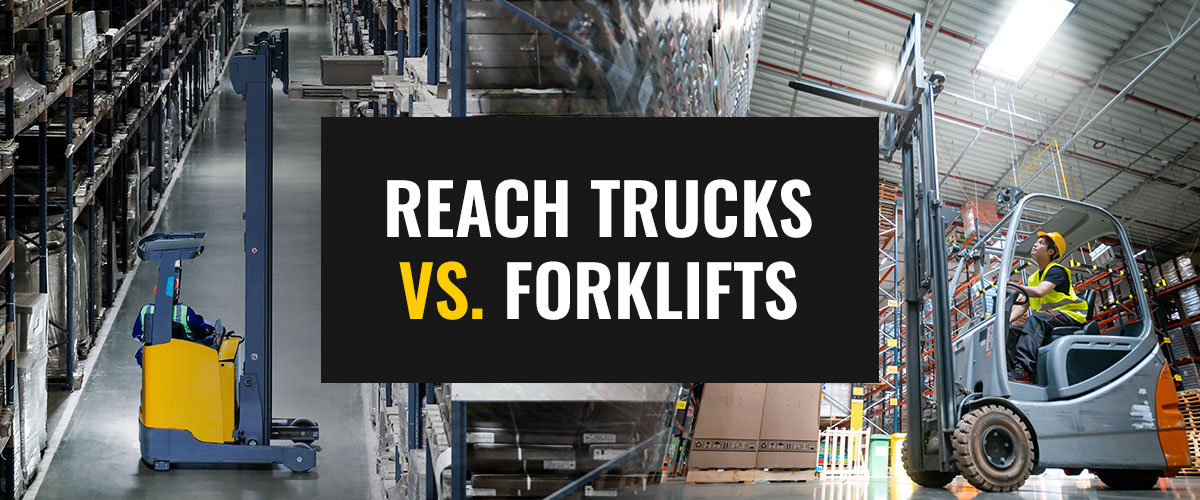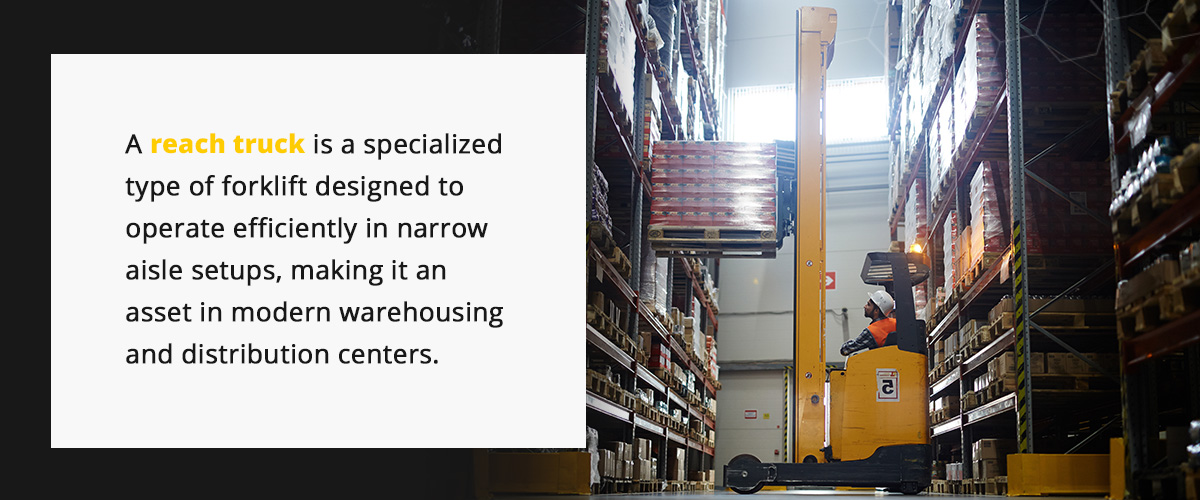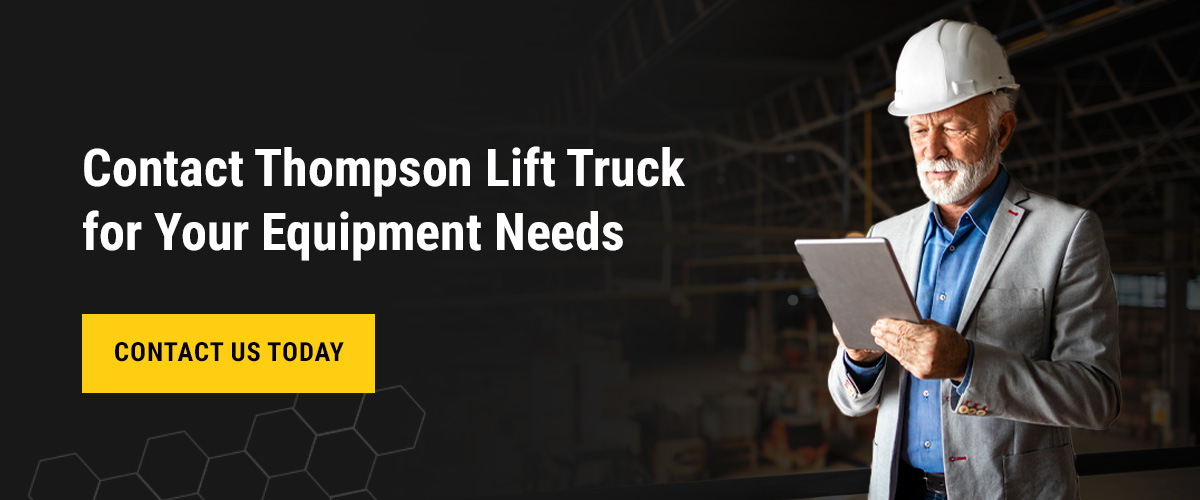
Reach Trucks Vs. Forklifts
Reach trucks and forklifts are two stalwarts of the material handling industry, each offering distinct advantages that cater to specific demands. Understanding the differences between these two equipment types allows managers to optimize productivity, safety, and space utilization in their warehouses and facilities.
What Is the Difference Between a Reach Truck and a Forklift?
Weighing the capabilities of a forklift versus a reach truck is an essential part of choosing the right equipment for your specific operational needs. Both reach trucks and forklifts are widely used in warehouses, distribution centers, and manufacturing facilities, but each excels in different aspects of material handling.
The differences between reach trucks and forklifts are what give each an edge in specific applications. Understanding these distinctions — starting with the defining features of each piece of equipment — will allow you to pick the option that maximizes safety and efficiency in your facility.
What Is a Reach Truck?
A reach truck, or reach forklift is a specialized type of forklift designed to operate efficiently in narrow aisle setups, making it an asset in modern warehousing and distribution centers. Unlike traditional forklifts, different reach trucks are engineered with specific features that allow them to operate and maneuver in tight spaces while maximizing their reach height.
Features of a reach truck / reach forklift include the following:
- Compact design: A reach truck’s compact design enables it to navigate through narrow aisles easily. Its reduced width allows for more efficient space utilization and allows warehouse managers to increase their storage density.
- Reach mechanism: The defining feature of a reach truck is its extendable mast and fork carriage system, which allows the forks to extend forward — this design element is what gives this forklift variant its name.
- Lift height: Reach trucks are engineered to reach greater heights than those achievable by traditional counterbalance forklifts. They can lift loads to heights of over 30 feet, making them ideal for multilevel storage configurations.
- Stabilizing legs: Reach trucks are equipped with stabilizing legs at the front of the vehicle. These legs extend forward and provide additional support to ensure stability when lifting heavy loads to great heights.
- Operator compartment: The operator’s compartment of a reach truck affords maximum visibility and comfort. The operator sits at a right angle to the direction of travel, facing the load, which allows for better visibility of the forks and load positioning.
Functionality and Applications
A reach forklift’s primary function is efficiently handling palletized loads within narrow aisle configurations. Reach trucks are commonly used for the following tasks:
- Pallet storage and retrieval: Reach trucks excel in storing and retrieving palletized loads from high racks, allowing managers to make the most of their warehouse’s square footage.
- Order picking: These material handlers are also utilized for order picking, where they retrieve individual items or pallets from designated locations within the warehouse.
- Inventory management: The precision and maneuverability of reach trucks make them valuable tools for inventory management, allowing for organized and efficient stock rotation.
- Stacking: Reach trucks are adept at stacking loads, particularly in high-rack storage systems, ensuring optimal use of vertical space.
- Load transportation: While primarily designed for warehouse tasks, reach trucks can also transport loads short distances within the facility.
What Is a Forklift?
A forklift, also called a lift truck or industrial truck, is a powerful and versatile material handling machine used in many industries and applications. This indispensable equipment is designed to lift, move, and stack various loads, making it a vital asset in warehouses, manufacturing facilities, construction sites, and distribution centers.
The key features of a forklift are as follows:
- Forks: The tines of a forklift are the primary lifting components. These forks slide under loads such as pallets, crates, or other objects, allowing the forklift to raise and transport them safely.
- Load capacity: Forklifts are available in various models with differing load capacities — depending on the type of forklift, they are capable of lifting anywhere from a few thousand pounds to over 50,000 pounds.
- Counterbalance design: Most forklifts are designed with a counterbalance weight, typically positioned at the rear of the machine. This design allows the forklift to lift and carry heavy loads without tipping forward.
- Lift height: Forklifts come equipped with hydraulic systems that elevate the forks, enabling them to reach elevated storage positions or load and unload materials from high surfaces.
Functionality and Applications
Forklifts are suitable for a wide range of material handling tasks, including:
- Loading and unloading: They can load and unload trucks, trailers, and shipping containers, streamlining the movement of goods in warehouses and distribution centers.
- Stacking: Forklifts can stack pallets or loads one on top of another, efficiently utilizing vertical space in warehouses and storage facilities.
- Transportation: These machines are ideal for transporting loads short distances within industrial settings.
- Construction: On construction sites, forklifts move building materials, equipment, and heavy loads, contributing to increased efficiency and reduced manual labor requirements.
Should I Purchase a Reach Truck or a Forklift?
Each type of equipment has unique strengths and advantages, and selecting the right one for your material handling needs will significantly impact operational efficiency and productivity. To make an informed decision, professionals should evaluate the following key factors:
Warehouse Layout and Space Utilization
Consider the layout of your warehouse or facility. A reach truck might be more suitable if you have narrow aisles and a high-rack storage system. Reach trucks are designed to operate in tight spaces efficiently so you can maximize vertical storage capacity. On the other hand, if your facility has a mix of narrow and wide aisles or requires outdoor material handling, a forklift’s ability to navigate various environments might be more advantageous.
Load Handling Requirements
Evaluate the types and sizes of loads typical to your operations. Reach trucks handle smaller to medium-sized loads within the narrow aisle setup. They are ideal for high-stacking applications and accessing deep storage positions. If your material handling tasks involve a diverse range of load sizes and weights, a forklift may be better suited to your needs.
Operator Training and Expertise
Evaluate the expertise of your operators and the level of training needed for each type of equipment. Reach trucks require personnel to undergo specialized instruction due to their unique design and narrow aisle operation. If your operators are experienced with reach trucks and narrow aisle handling, this equipment might be the more efficient choice.
Budget and Long-Term Investment
Reach trucks tend to have a higher initial cost than standard forklifts due to their specialized design and advanced features. However, they can optimize storage capacity and increase operational efficiency in narrow aisles, potentially providing a better return on investment for specific applications.
Contact Thompson Lift Truck for Your Equipment Needs
With our extensive range of used and new forklifts and other specialized equipment, we are committed to providing tailored solutions that optimize your material handling operations. At Thompson Lift Truck, we don’t just supply equipment — we offer warehousing solutions, material handling equipment rentals, maintenance services, and comprehensive support to ensure that your investment yields an excellent return.
We are committed to excellence, safety, and customer satisfaction in everything we do. Contact us today for a quote to enhance your material handling operations and drive success for your business.



